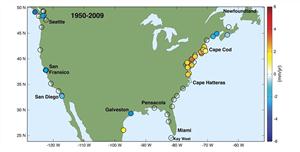This is Part 1 of a two-part series on the insurance industry’s calculations about climate change as it affects the coast.
As the 2012 hurricane season winds down, residents in North Carolina’s coastal communities hope they’ve been spared the worst and brace for the potential of hundreds of dollars in property insurance increases.
Supporter Spotlight
The possibility of homeowner’s insurance rate hikes along the coast come as scientific research continues to evidence climate change as the driving force behind increasing numbers of catastrophic weather events over the past three decades.
The debate in America over how insurance companies should assess risks in coastal areas is as emotionally charged and highly politicized as that of global warming.
No matter where you stand on the issue of climate change, experts say one thing is certain – insurance companies and the underwriters that insure them are paying close attention to scientific projections that Atlantic storms will become more frequent and stronger.
“In general, it certainly is an issue in the insurance industry,” said Dr. David Marlett, professor and chair of the Department of Finance, Banking and Insurance at Appalachian State University in Boone. “When insurance companies are not sure, they raise their rates. They’re going to err on the side of caution.”
In its latest study released last month, Munich Re, the world’s largest reinsurer, stated that North America has seen the biggest increase in the world in natural catastrophes in the past 30 years, a direct result of global warming.
Supporter Spotlight
A study published in September by Ceres, a nonprofit business sustainability group that works closely with the insurance industry, warns that extreme weather risks, including rising sea levels, are growing for the property and casualty insurance sector.
“The insurance industry really is on the front line here when it comes to changes in the impacts of our weather,” said Cynthia McHale, director of Ceres’ insurance program and co-author of Stormy Future for U.S. Property/Casualty Insurers: The Growing Costs and Risks of Extreme Weather Events.
“That’s something you can’t ignore,” she said. “It’s a very straightforward discussion. When you look at that weather pattern over a 30-year period, you can see a trend. This is what we can reasonably expect to see more of in the future.”
Extreme weather events cost insurers more than $32 billion in losses last year, according to the Ceres report. The industry’s net underwriting loss in 2011 was $34 billion, a result of a record 99 disaster declarations by the federal government.
Average temperatures have risen in the past 50 years. Extremely hot summers are 40 times more frequent, according to the report.
 Differences in rates of sea-level rise from tide-gauge records across North America over a 60-year period (1950–2009). Figure by USGS |
The last half-century has experienced more frequent and intense heat waves, droughts and floods. The hurricane season has been lengthened. Higher ocean surface temperatures, which are expected to continue at least five years, are fueling stronger storms and rising sea levels will likely create larger storm surges, according to the report.
In May 2011, Risk Management Solutions, Inc., the market leader in catastrophic risk modeling, released a new model for Atlantic tropical storms.
RMS predicts that the likelihood of a Category 3 hurricane making landfall on the U.S. coast will be 20 percent higher than previously modeled. On average, modeled losses will increase by 40 percent on average for the Gulf Coast, Florida and the Southeast, according to the report.
These trends have made insuring coastal properties unattractive in the past decade, Marlett said.
“With the reinsurance companies, they’re particularly concerned about this because they insure catastrophic losses,” he said. “When you throw in climate change where there’s uncertainty with that risk, that makes it even worse. When a reinsurance company is selling their protection to an insurance company, if they raise their rates that means that the insurance company will have to pay more and they will increase their rates.”
The state Department of Insurance is considering a request by the North Carolina Rate Bureau to raise rates in coastal counties by 30 percent and statewide by an average 17.7 percent.
Insurance Commissioner Wayne Goodwin has said no decision will be made until after a public hearing set for June 3, 2013.
Coastal residents, business owners and the towns and counties in which they live argue the proposed increase places an excessive burden on homeowners and would stifle economic development along the coast. Opponents agree that insurance rates should be based on actuarial data rather than modeled projected losses.
This fight comes on the heels of another heavily contested dispute about the rate at which the Atlantic Ocean is rising.
To be continued tomorrow…







